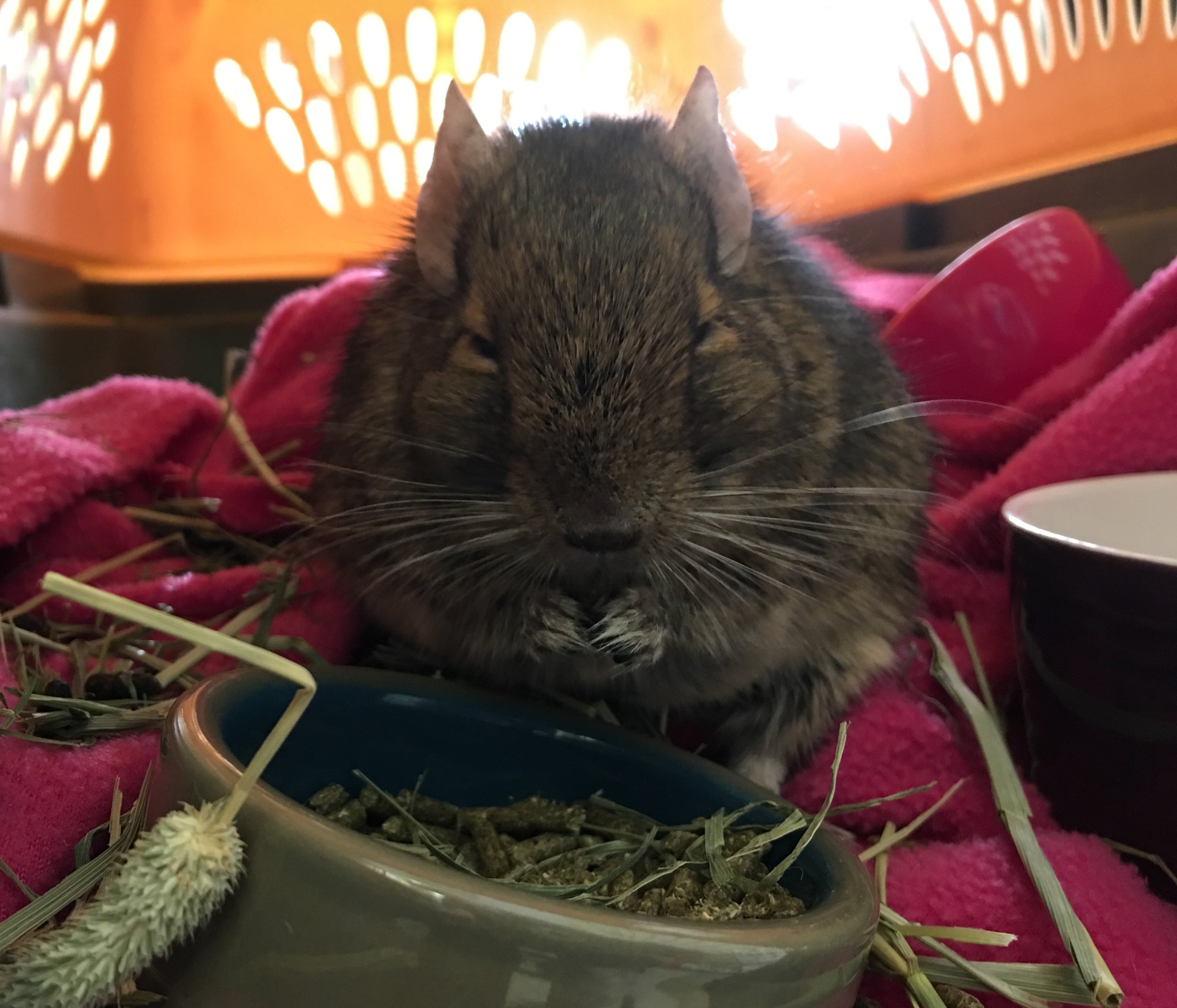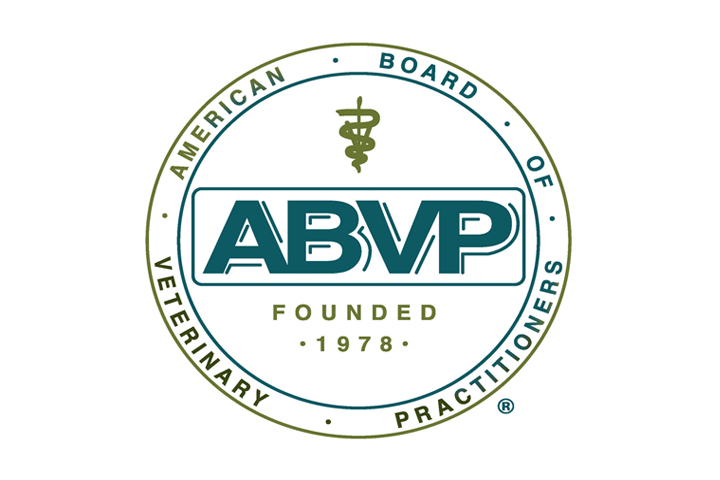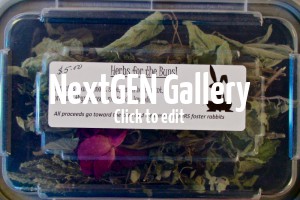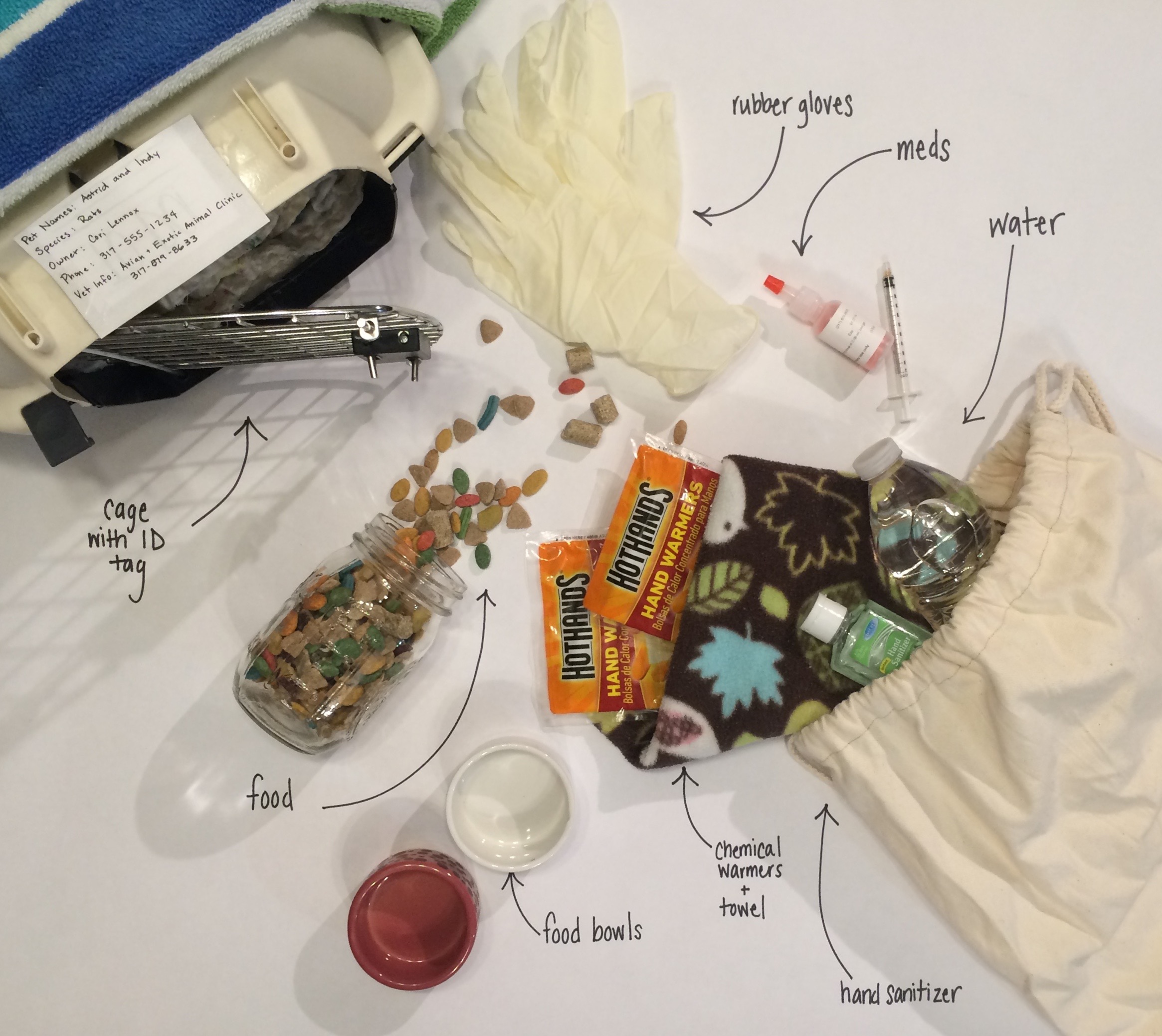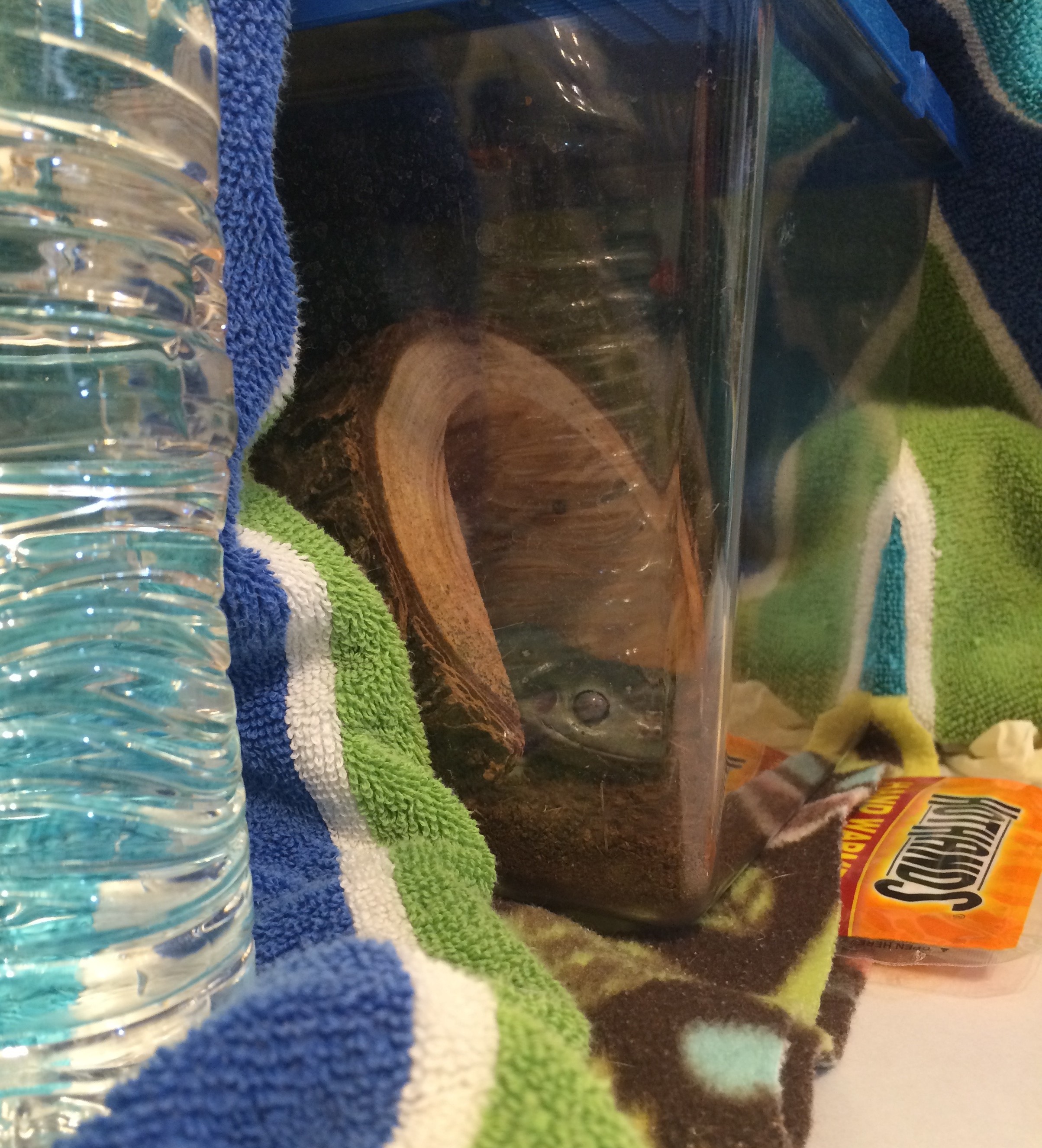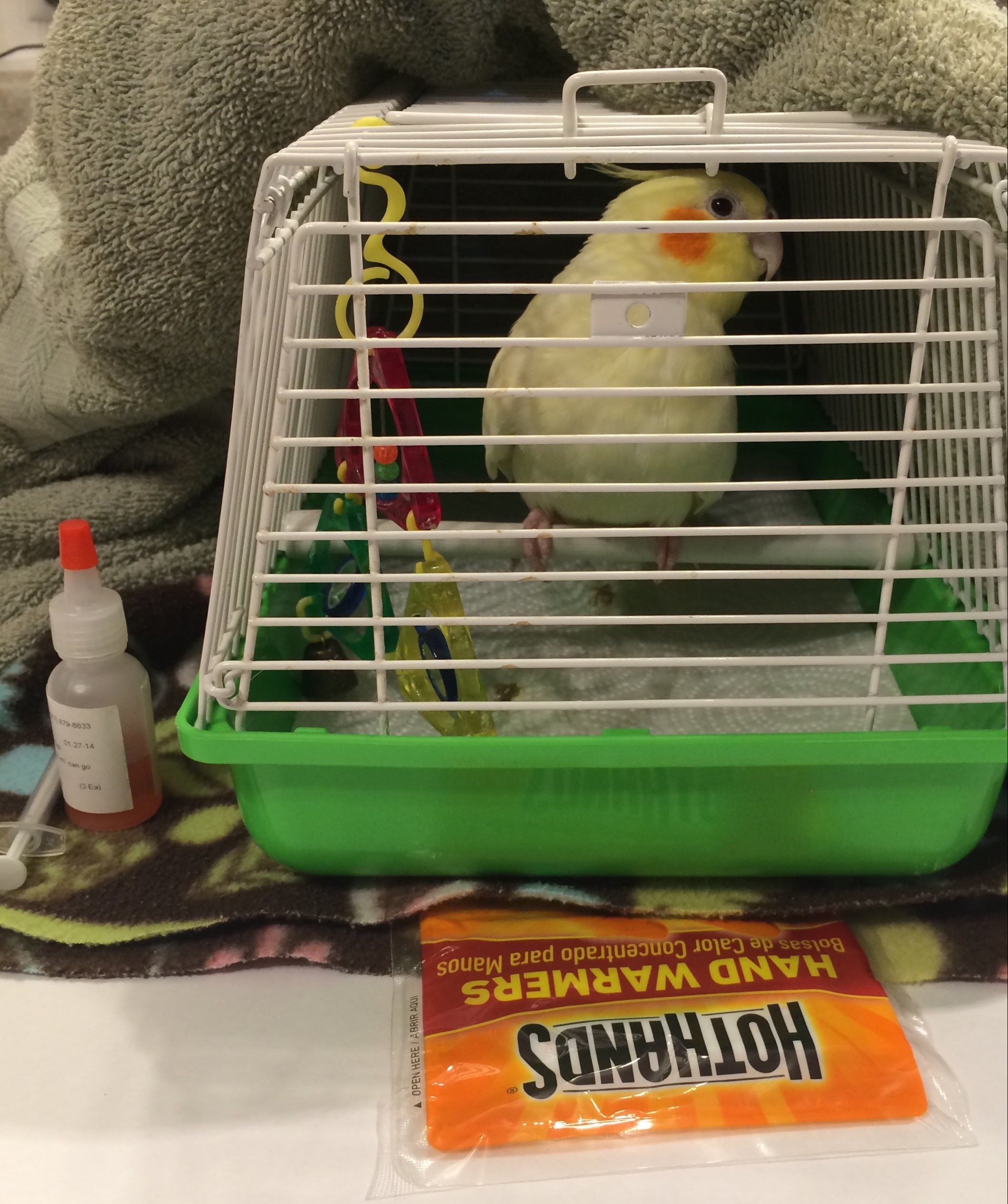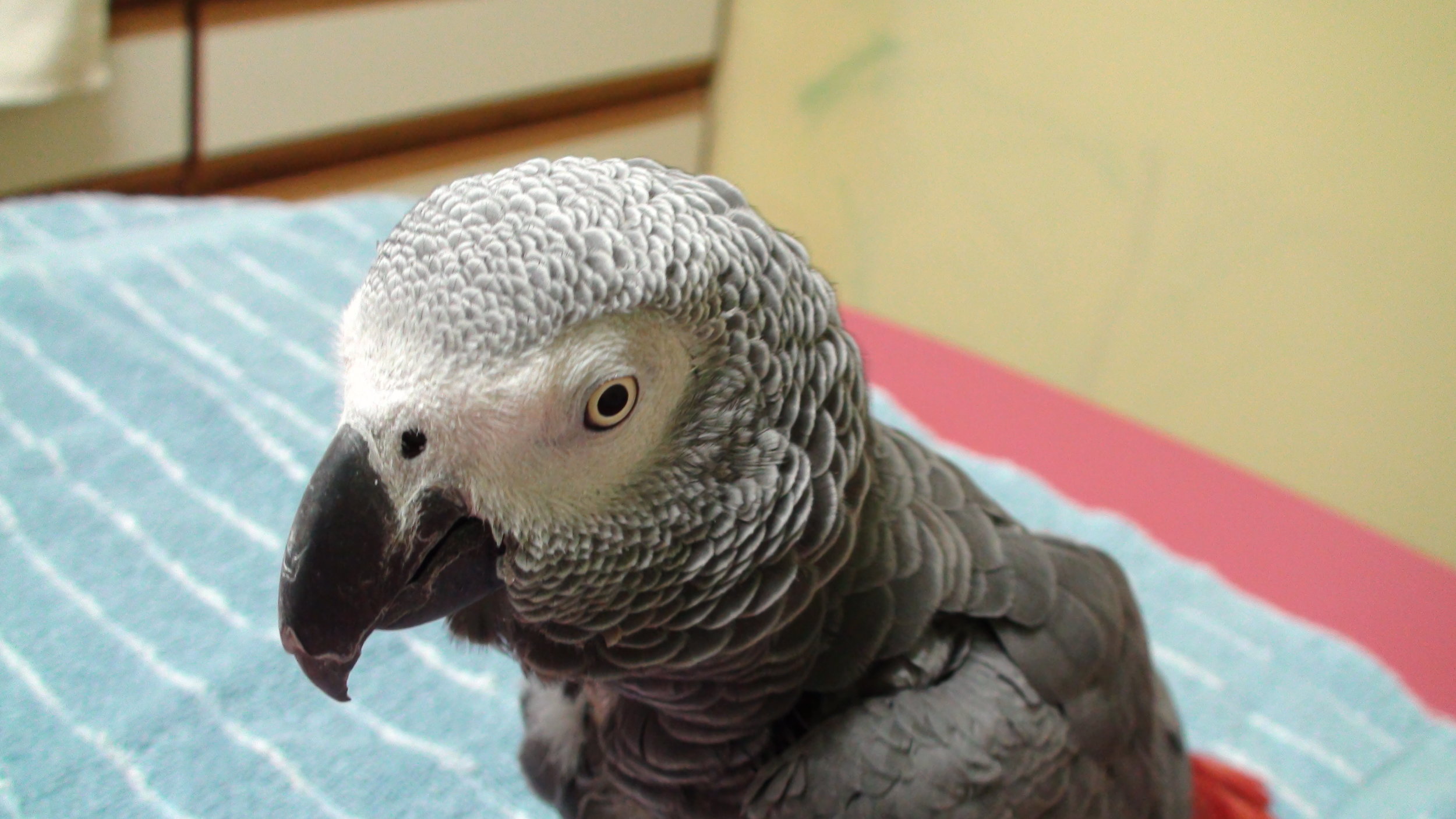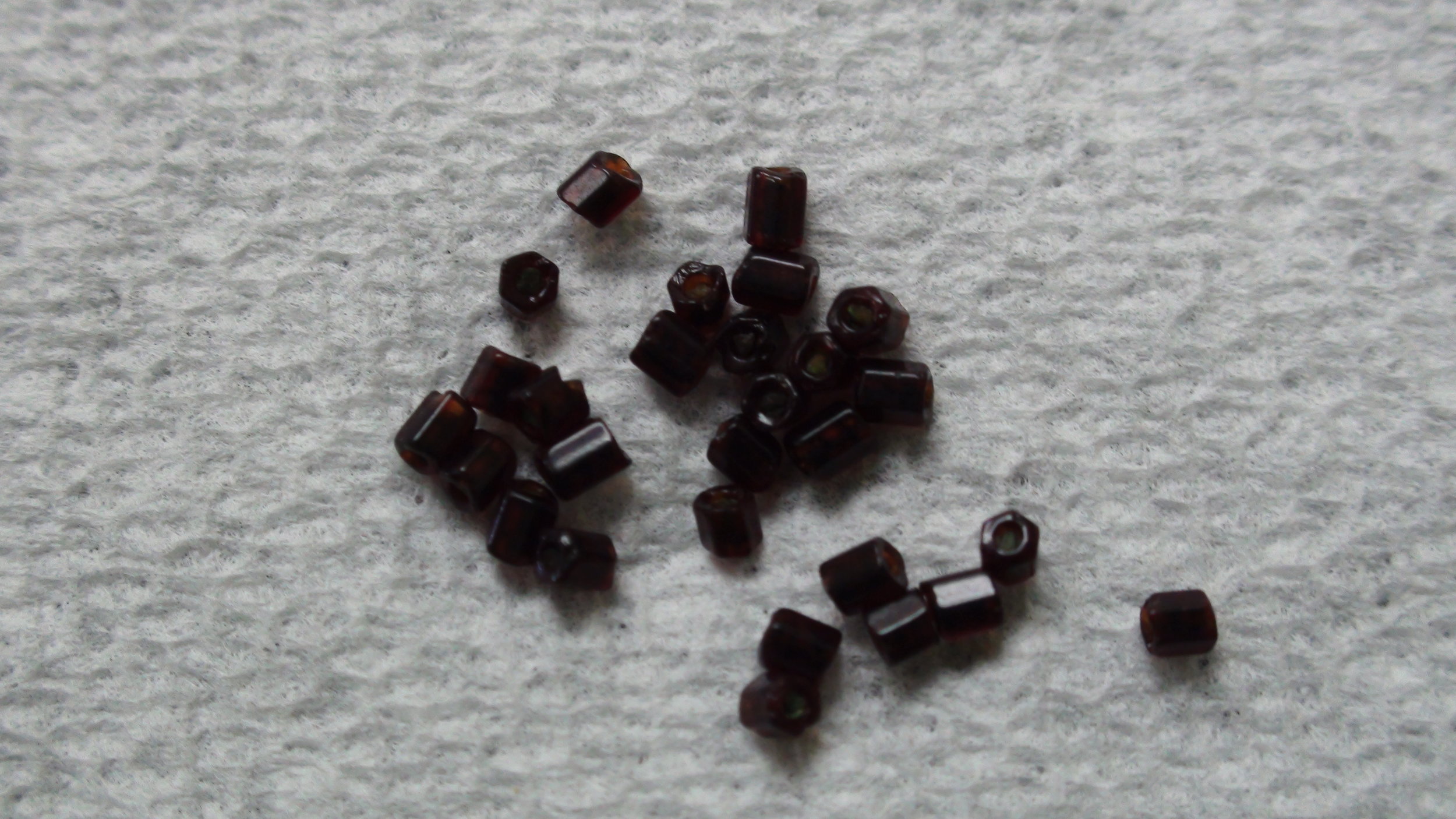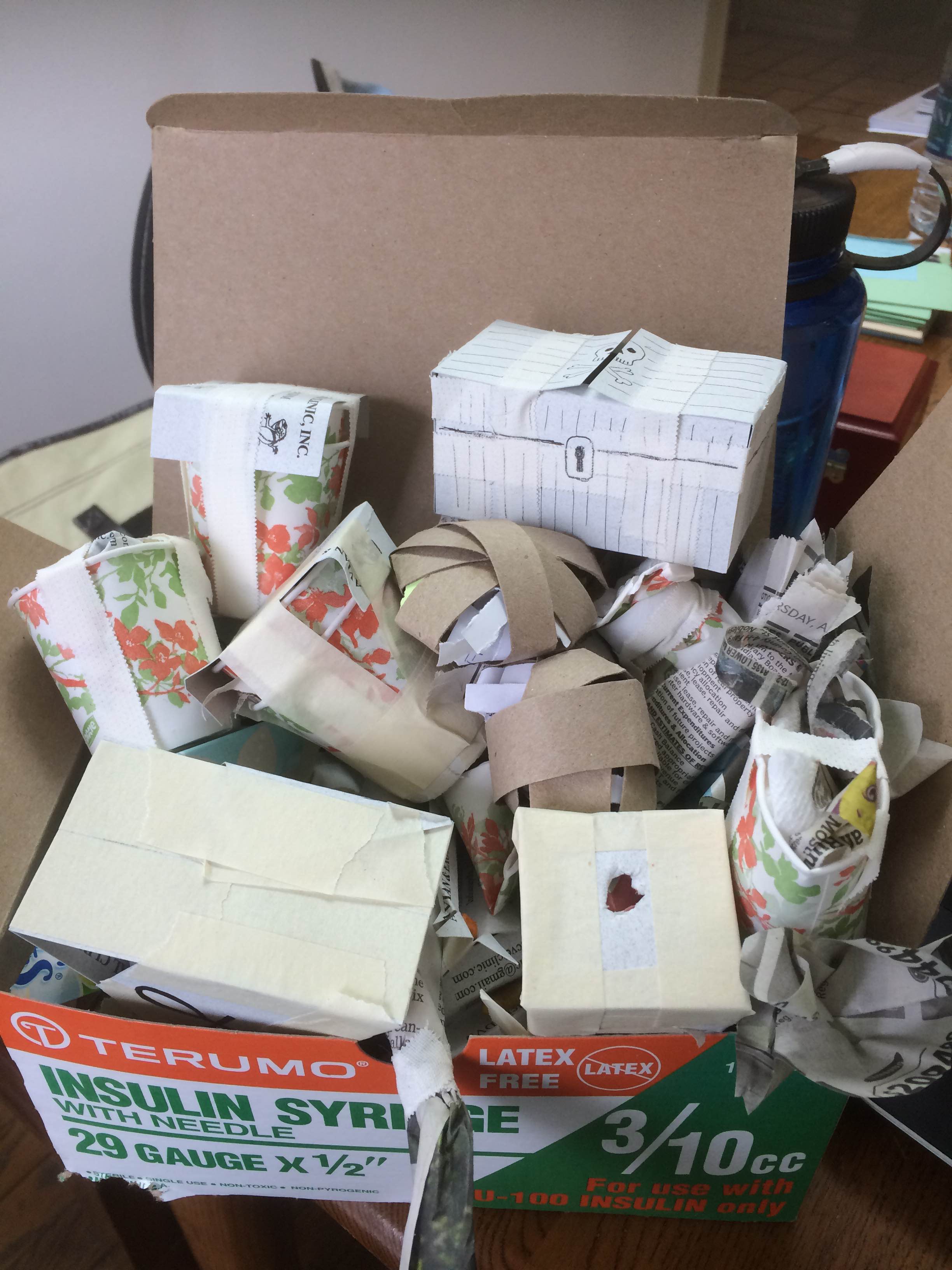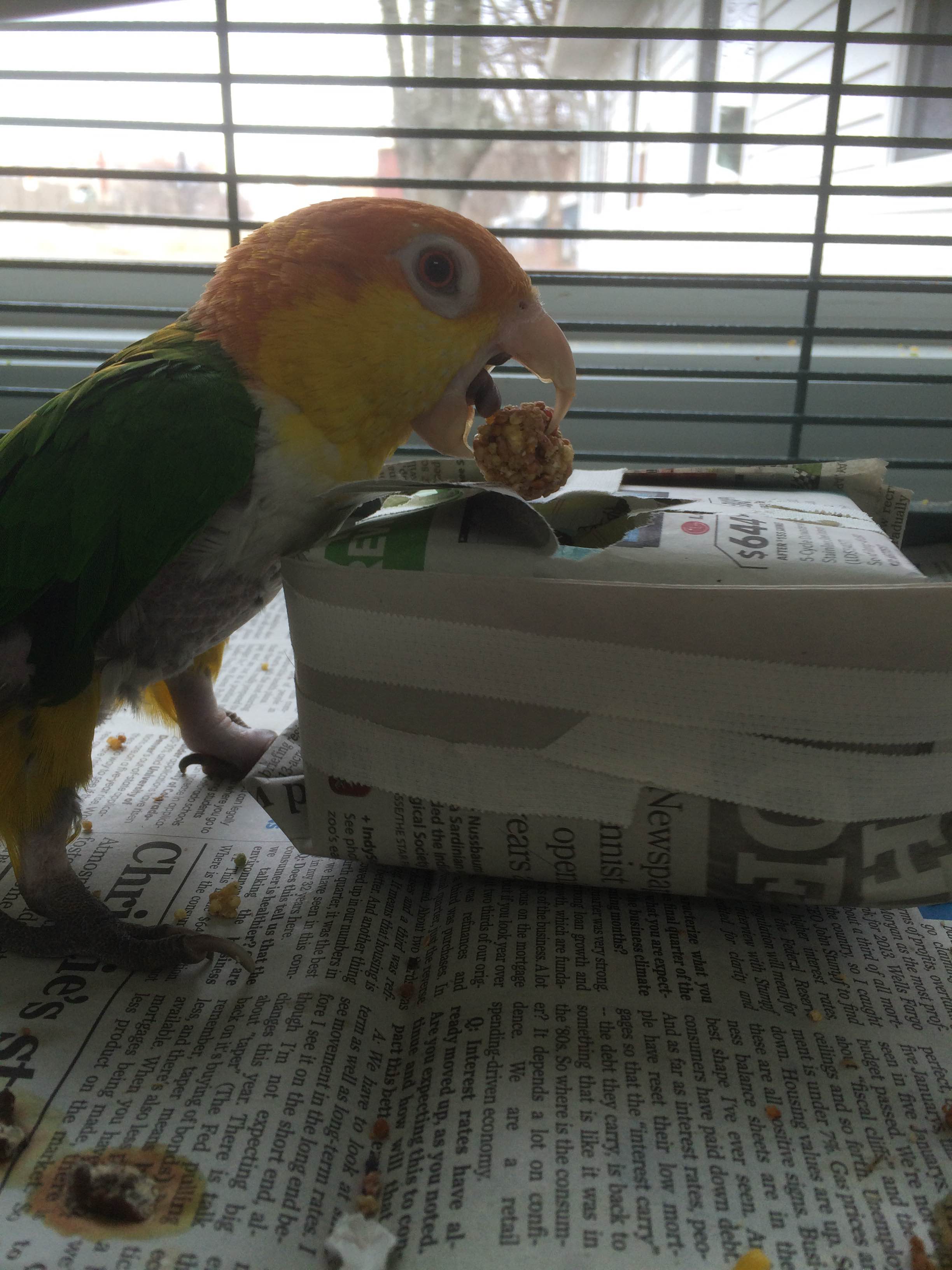It is with h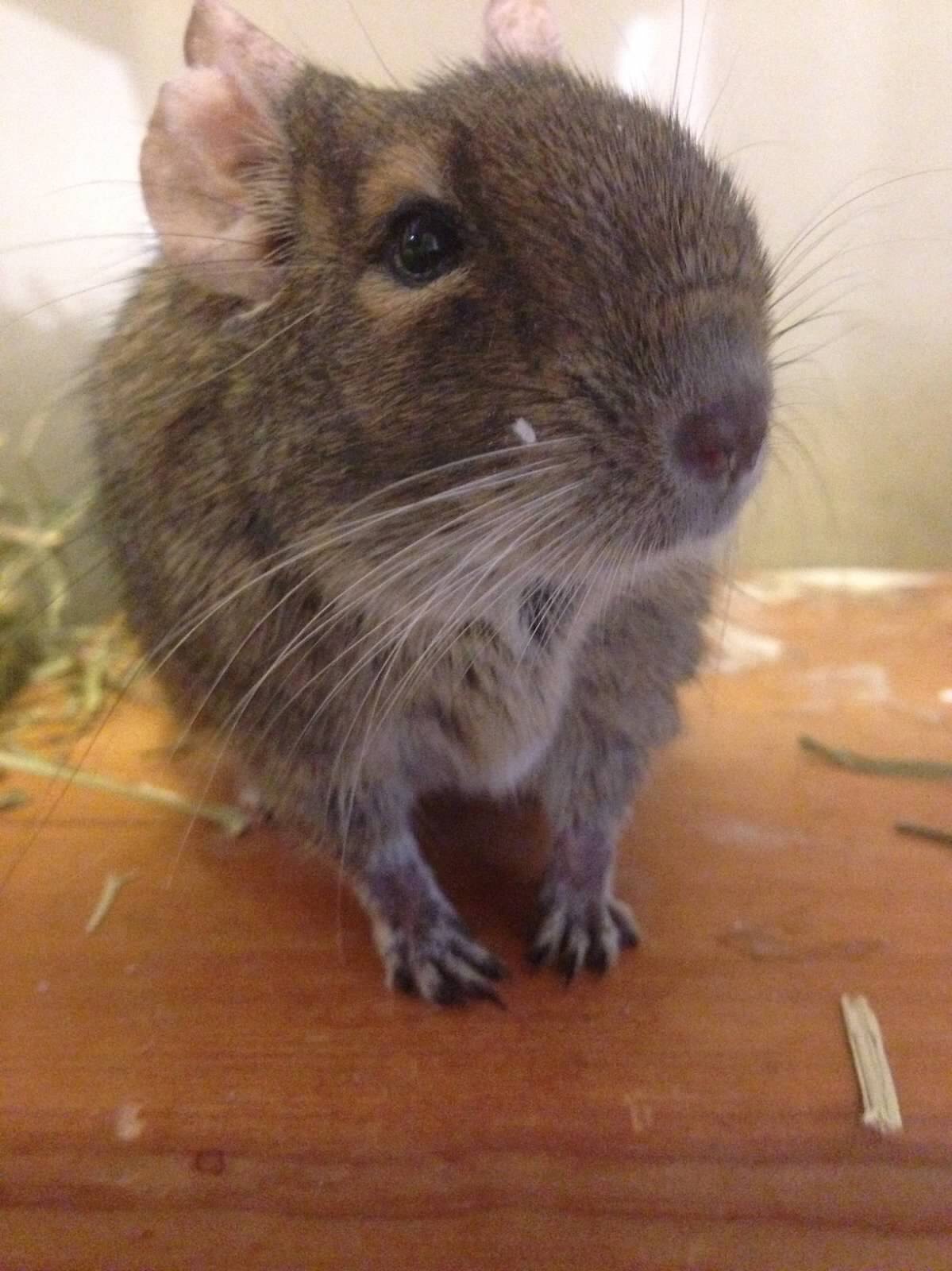 eavy hearts that we announce the passing of Phil, the clinic degu. Phil came to us nearly 8 years ago as an adult, though no one was quite sure of his actual age. He, unlike most of his species, couldn’t stand living with other degus and had to be kept separately from his family. He lived alone quite happily in one of our exam rooms, where many of you may have seen and interacted with him. Phil enjoyed exploring the clinic in his giant hamster ball while his cage was being cleaned, being scratched (but not picked up!) and rearranging his cage furniture. About 6 months ago, Phil started to have some health problems and it was decided that it was time for him to retire as clinic pet. He went to live with our receptionist Megan, where he enjoyed hanging out on the couch getting snuggled during movie time and sleeping against the side of the cage against his cat friend Samurai Sam. When in his ball, he particularly liked forming trains with Megan's other pets to follow her around the house! Megan spoiled him rotten until he finally passed on Saturday. All of us will miss him greatly. As a legacy to Phil, we are opening his cage up to adoptable animals from one of our local rescues. Next time you are in the clinic, be sure to visit our first adoption candidate Dora the Gerbil!
eavy hearts that we announce the passing of Phil, the clinic degu. Phil came to us nearly 8 years ago as an adult, though no one was quite sure of his actual age. He, unlike most of his species, couldn’t stand living with other degus and had to be kept separately from his family. He lived alone quite happily in one of our exam rooms, where many of you may have seen and interacted with him. Phil enjoyed exploring the clinic in his giant hamster ball while his cage was being cleaned, being scratched (but not picked up!) and rearranging his cage furniture. About 6 months ago, Phil started to have some health problems and it was decided that it was time for him to retire as clinic pet. He went to live with our receptionist Megan, where he enjoyed hanging out on the couch getting snuggled during movie time and sleeping against the side of the cage against his cat friend Samurai Sam. When in his ball, he particularly liked forming trains with Megan's other pets to follow her around the house! Megan spoiled him rotten until he finally passed on Saturday. All of us will miss him greatly. As a legacy to Phil, we are opening his cage up to adoptable animals from one of our local rescues. Next time you are in the clinic, be sure to visit our first adoption candidate Dora the Gerbil!
Goodbye, Mari!
This week we say good by to veterinary visitor Maria Rosa de Jaureguizar i Tesas from Spain. She was a terrific help with all of our post surgical and hospital patients, and we enjoyed learning a bit more about Spanish culture and traditions! Thank you, Mari. Here's Mari's report-
I had the great opportunity to visit here for 2 month. I remember the day I arrived, a new graduate veterinarian in a new country on a very busy surgeries day. I remember that when I came in the hospitalization area there were a lot of rabbits waiting for a surgery. I was so amazed! I had never seen so many surgeries on exotic animals in one day before! Moreover, I've seen a lot of challenging cases, great diagnostic approach and great protocol treatment for exotic pets and wildlife. Some of the most interesting things I have seen here were an undifferenciate soft tissue sarcoma in a chinchilla which was treated with radiation therapy, hypertrophic cardiomyopathy in a bunny, dilated cardiomyopathy in an skunk, foreign body gastrointestinal obstruction in one arctic fox, an obstruction of the lacrimal canal in one African Grey Parrot caused by the epithelial duct hyperplasia secondary to hypovitamin A, one bearded dragon with one colonic mass, perform barium contrast in one snake. There were a lot of neurological and ophthalmologic cases too. I've seen endoscopy in a Crested Cockatoo with reproductive disease and bronchoscopy in an African Grey Parrot with bleeding coming from the larynx.
. This clinic is an excellent educational center for veterinary students, veterinary technicians and veterinarians who are interested in exotic pets. They share their knowledge and practice together every day. Every week, we participated in a journal club, where we read and discuss the new exotic animals articles published. That's a great way to keep in touch with the latest advancements. I studied, practiced and learned so much with them! Dr. Lennox and all her staff are really nice and friendly. During my stay here I could share with them a lot of American and Spanish traditions, from the Thanksgiving day to New Year grapes and the typical Spanish Paella! They became my Indy family, and from the first day until the last one I felt at home. I really want to thank you everything you gave me. I'll miss you!
-Mari
Bunny Whisperer
 Last week we welcomed our "Bunny Whisperer" Mr. Bill Lee to help socialize and brush some of the many EARPS rescue rabbits.
Bill is a retired builder, who actually built most of our clinic additions, but is enjoying a well deserved retirement. What better way to spend that time than as a Bunny Socializer?
Last week we welcomed our "Bunny Whisperer" Mr. Bill Lee to help socialize and brush some of the many EARPS rescue rabbits.
Bill is a retired builder, who actually built most of our clinic additions, but is enjoying a well deserved retirement. What better way to spend that time than as a Bunny Socializer?
Bill was able to give the EARPS placement coordinators valuable information on each rabbit's personality.
EARPS has lots of volunteer opportunities; to find out more, email volunteer@earps.org
Oxbow Animal Health Vet Connect
From the Oxbow website: Oxbow Vet Connect puts valuable educational resources and product information at the fingertips of busy veterinary professionals. Whether you’re in need of precise, one click dosing recommendations for our Professional Line products, informational videos and educational articles, CE credit opportunities, or easy ordering for all Oxbow products, Oxbow Vet Connect is there to help. Access these resources and more at www.OxbowVetConnect.com
Sign up and log in to see videos on blind intubation of rabbits, and incisor extractions in rabbits, and more:
Professional Line Dosage Calculator
From alpacas to wallabies, our Professional Line Dosage Calculator provides accurate, one click dosaging information for over 150 species of carnivores, herbivores, and omnivores. Simply enter species, age, weight, and current nutrition source to calculate dosage information in grams and tablespoons. With the calculator, accurate professional line dosaging is available whenever critical cases present themselves, day or night.
Educational Content from Industry Experts
At Oxbow, we applaud every veterinarian’s oat to the continued improvement of professional knowledge. To help you fulfill this oath, we are proud to offer our ever-growing library of educational videos and articles. Our video library features high definition content relating to procedures, diagnoses, treatment plans, and general exotics care. Printable resources include articles, case studies, and client education materials.
Continuing Education
Continuing Education coursework helps you further your professional knowledge and grow as a veterinary professional. Oxbow Vet Connect’s intuitive eLearning platform allows you to log on, complete coursework, and receive your RACE-approved credit all in one session. Log on to Oxbow Vet Connect today to view and enroll in our growing library of Continuing Education courses.
Christmas Pets
 Introducing Mr. White, the official First Christmas Pet of the Season! We saw Mr. White today for his first wellness check, just a few days after Santa delivered him to his new home. We applaud Santa for being able to keep new Christmas exotic pets warm and safe during their long trips from the North Pole. :)
All new exotic pets deserve a wellness visit to start their New Year off right and wellness exams are a big part of that!
Introducing Mr. White, the official First Christmas Pet of the Season! We saw Mr. White today for his first wellness check, just a few days after Santa delivered him to his new home. We applaud Santa for being able to keep new Christmas exotic pets warm and safe during their long trips from the North Pole. :)
All new exotic pets deserve a wellness visit to start their New Year off right and wellness exams are a big part of that!
Most exotic pet species are masters at hiding illness from owners. Most are prey species, and an important survival trick is to hide injury and illness to prevent predators from targeting them. Therefore, regular veterinary visits are important to help detect early indications of illness. During a normal well pet visit, the staff will go over many aspects of pet care, discuss ways to detect early disease and minimize preventable illness, and share any new advances in exotic pet care that might benefit your special pet. All new pets go home with written care instructions.
American Board of Veterinary Practitioners in New Orleans
November marked the 20th Conference of the American Board of Veterinary Practitioners in New Orleans. The focus of the exotics program (Avian, Exotic Companion Mammal and Reptile/Amphibian) was Evidence Based Medicine, and how we can critically evaluate information sources. This is of special importance in exotic medicine, which despite advances, lags behind other traditional pet species. One entire presentation focused on critical evaluation of drug dosages published in exotic animal formularies. Most dosages from these sources are anecdotally-derived only, with very few pharmacokinetic or efficacy studies. This is especially concerning when we learn that existing pharmacokinetics show differences in how parrots metabolize the same drug. So a drug dosage found to be useful in one type of parrot may not be useful in another.Other presentations focused on how to interpret current information on hot topics such as E. cuniculi in rabbits, the use of GnRH agonists in various exotics and diagnose of liver disease in birds using so called "liver enzymes" (not a good idea by the way!). Consider ABVP in 2016 in San Antonio October 6-9th for CE for canine/feline/shelter medicin/exotic species and more . Check out www.abvp.com for more details.
From the ABVP website:
"ABVP certifies veterinary practitioners with exceptional knowledge, skill, and competency in the care of the total patient. ABVP Diplomates are certified in clinical practice for the species in which certification is granted. Clinical practice, as it pertains to veterinarians, is the art and science of applying medical knowledge to animals for their care and the alleviation and prevention of their diseases.
Most veterinarians performing broad-based clinical practice are not board certified. The ABVP board certified veterinarian has demonstrated they are capable of providing a level of clinical practice that is clearly superior to the norm of the profession."
Pet Gifts to Support a Good Cause!
Swing by the clinic this holiday season to pick up some festive gifts for your pets! All proceeds go to the Exotic Animal Rescue and Pet Santuary (EARPS) and the Indiana House Rabbit Society (IHRS). Thank you for supporting great causes!
To learn more about these great organizations, check their websites -
http://indianahrs.org/
http://earps.org/EARPS,_Inc/Home.html
Walkin' in a Winter Wonderland
Thankfully we are through the polar vortex and heavy snow of last week! Unfortunately, it looks like temperatures will soon be dropping again, though. If you don't have one in place, now is the time to be sure your bad weather/power outage plan is ready! Many exotics pets do not tolerate temperature decreases well, especially tropical reptiles and small birds such as finches (especially the Gouldian finch). So, before the next cold snap, be sure you have the following:
- A backup source of heat, such as a generator or wood-burning heat source, with proper ventilation to protect pets from fumes
- An alternative backup location (boarding facility/hotel/friends' homes) that will temporarily house your pets if you have to leave the house
- A labeled, safe and secure carrier for each and every pet for transport
- A travel container with pet foods, bowls and medications
- Portable chemical heaters (for camping, hunting or cold weather sporting events) that can be placed close enough to provide warmth, but protected from chewing and puncturing.
Call us for advice and emergencies, should the need arise.
We wish you a safe and warm winter season! We will update you with what to do when the weather is too HOT in about 6 months!
Teaching in Asia: Part 2
 The conference in Japan was hosted by the Japanese Society of Exotic Pet Medicine (JSEPM) http://www.jsepm.com/ and the Japanese Association of Avian Medicine
The conference in Japan was hosted by the Japanese Society of Exotic Pet Medicine (JSEPM) http://www.jsepm.com/ and the Japanese Association of Avian Medicine
The first two days were all mammal topics, and the third day all avian topics. In between we feasted on authentic Japanese cuisine and explored Japanese culture. Our hosts were very kind, enthusiastic, and best of all, had a great sense of humor.
 In order to lecture in Japan, my lectures were translated by the very talented veterinarian Dr. Masayuki Naoi. It was interesting to hear what I said in repeated in Japanese. Here is Dr. Naoi on the left, and conference organizer Yasutsugu Miwa on the right.
In order to lecture in Japan, my lectures were translated by the very talented veterinarian Dr. Masayuki Naoi. It was interesting to hear what I said in repeated in Japanese. Here is Dr. Naoi on the left, and conference organizer Yasutsugu Miwa on the right.
 The day in between the mammal and avian lectures, I bought a cute little budgie to bring back with me to the states. I even brought him to the avian lectures the next day to show everyone. After the break I returned to find my hosts had given the bird permission to take over for me.
The day in between the mammal and avian lectures, I bought a cute little budgie to bring back with me to the states. I even brought him to the avian lectures the next day to show everyone. After the break I returned to find my hosts had given the bird permission to take over for me.
Teaching in Asia: Part 1
Hong Kong
 Our one day conference was well attended, and was scheduled from 3-10 PM, which makes for a late night.
Our one day conference was well attended, and was scheduled from 3-10 PM, which makes for a late night.
 The next day was a free day. We started with breakfast: some chick pea curry with rice and bacon. But no worry, I was able to find a container of good old oatmeal and some gluten free toast. We met a group of veterinarians at the conference who practice 70% exotics at the Tai Wai Small Animal and Exotic Hospital Hong Kong, and we were invited to come see their clinic and the Kaddorie Farm and Botanic Gardens, where some of the staff volunteer from time to time.
The next day was a free day. We started with breakfast: some chick pea curry with rice and bacon. But no worry, I was able to find a container of good old oatmeal and some gluten free toast. We met a group of veterinarians at the conference who practice 70% exotics at the Tai Wai Small Animal and Exotic Hospital Hong Kong, and we were invited to come see their clinic and the Kaddorie Farm and Botanic Gardens, where some of the staff volunteer from time to time.
 This wildlife facility at Kadoorie Farm sees all the kinds of wildlife you might expect, like hawk and owls, with some other, more unique critters like macaques, barking deer, small wildcats and probably the most DARLING animal in the world: pangolins. They also see reptiles, and lots and lots of .....snakes.
Apparently Hong Kong is crawling with Burmese pythons, which is a pet species we see a lot in our practice, but they are native wildlife here. And they have a dozen or more venomous snakes including cobras. Every
This wildlife facility at Kadoorie Farm sees all the kinds of wildlife you might expect, like hawk and owls, with some other, more unique critters like macaques, barking deer, small wildcats and probably the most DARLING animal in the world: pangolins. They also see reptiles, and lots and lots of .....snakes.
Apparently Hong Kong is crawling with Burmese pythons, which is a pet species we see a lot in our practice, but they are native wildlife here. And they have a dozen or more venomous snakes including cobras. Every  day, the police get calls about snakes that are found in places like people's porches, yards, the street, or even in the houses. The police call a group of snake catchers who, years ago would catch the snakes and take them to restaurants for people to eat. Fortunately, that is not the case now- the police pay these professionals to catch them, put them in special bags that go inside special boxes. The police then transport the box to this wildlife facility along with a description of what they think the snake may be, and how big it is. The staff carefully opens the box, gets the bag, opens it and peeks in. Then they catch the snake with snake tongs and gloves and check it for injuries. If it's in good shape, the
day, the police get calls about snakes that are found in places like people's porches, yards, the street, or even in the houses. The police call a group of snake catchers who, years ago would catch the snakes and take them to restaurants for people to eat. Fortunately, that is not the case now- the police pay these professionals to catch them, put them in special bags that go inside special boxes. The police then transport the box to this wildlife facility along with a description of what they think the snake may be, and how big it is. The staff carefully opens the box, gets the bag, opens it and peeks in. Then they catch the snake with snake tongs and gloves and check it for injuries. If it's in good shape, the  snake is put back in the bag and into a large box either marked "venomous" or "non-venomous". I looked in the boxes and there were about 7 bags in the "venomous" box and 4 in the "non-venomous" box. Then they are released eventually to safer places. The largest snake brought in this day was identified by the police as a "Burmese Cobra". The staff at the wildlife center asked us to leave the room for that bag, just in case it was a cobra! Thankfully it was actually......a Burmese python! We see these guys frequently in our exam room. I took a good look at what a nice healthy wild caught python is supposed to look like.
We also saw a lot of turtles, including some unusual species the wildlife center is trying to replenish in the wild.
snake is put back in the bag and into a large box either marked "venomous" or "non-venomous". I looked in the boxes and there were about 7 bags in the "venomous" box and 4 in the "non-venomous" box. Then they are released eventually to safer places. The largest snake brought in this day was identified by the police as a "Burmese Cobra". The staff at the wildlife center asked us to leave the room for that bag, just in case it was a cobra! Thankfully it was actually......a Burmese python! We see these guys frequently in our exam room. I took a good look at what a nice healthy wild caught python is supposed to look like.
We also saw a lot of turtles, including some unusual species the wildlife center is trying to replenish in the wild.
Next stop: Tokyo!
An Unexpected Visitor
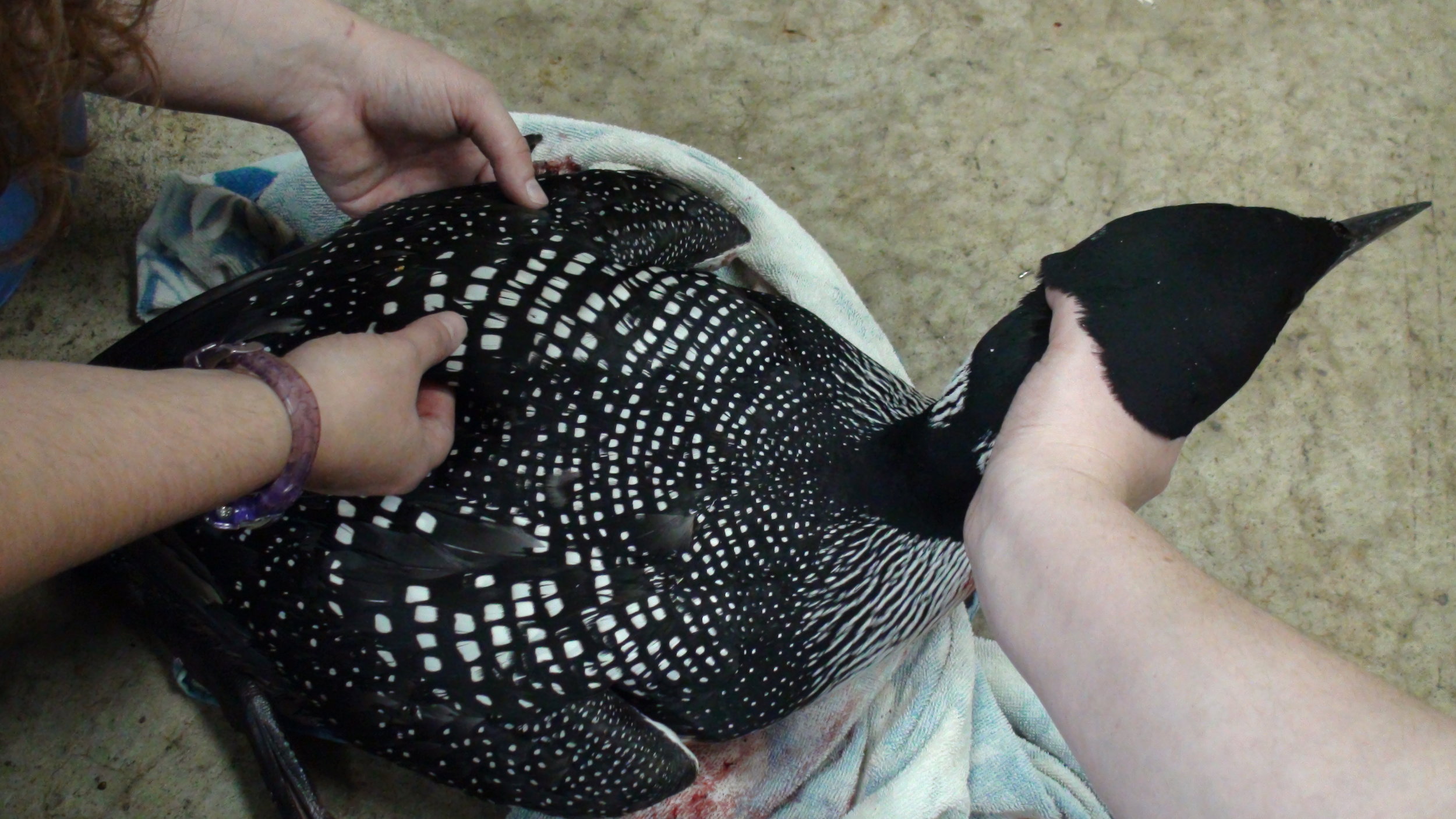 This beautiful bird visited us after getting into some trouble. This is a common loon. His only injuries were multiple damaged and bleeding toes. The loon is an amazing water bird, but can't actually take off from land, so if they accidentally mistake a shiny water covered road or parking lot for water, they can injure themselves during landing, and then not be able to take off again. This is what we think happened to this bird. Our visiting vet student Jennifer cared for his wounds, and he's off to heal and eventually be released again-onto a nice, full body of water this time.
This beautiful bird visited us after getting into some trouble. This is a common loon. His only injuries were multiple damaged and bleeding toes. The loon is an amazing water bird, but can't actually take off from land, so if they accidentally mistake a shiny water covered road or parking lot for water, they can injure themselves during landing, and then not be able to take off again. This is what we think happened to this bird. Our visiting vet student Jennifer cared for his wounds, and he's off to heal and eventually be released again-onto a nice, full body of water this time.
Why it's Way Important to Find An Easy Way to Weigh
Coming to Avian and Exotic Animal Clinic in October!

Did you know that a digital scale is one of the most important preventative medical devices you can buy for your exotic pets? Most exotic pets are expert at hiding signs of illness, and fur and feathers can hide weight loss, even from experienced owners. (This is especially true for pet birds!) That's why an inexpensive gram scale can be one of your best tools to help note early weight loss, which often accompanies illness in any pet. Pets can be trained to sit on the scale in a box or on a perch in exchange for a treat. This is why all pets boarded at the Avian and Exotic Animal Clinic are weighed on a gram scale multiple times during their stays.
Recently we learned of the sad experience of an owner whose pet stayed at a friend's house for babysitting. Within two days of coming back home, the pet was in our hospital, completely emaciated, and did not survive. Both the experienced babysitter and the owner were completely unaware of the severe weight loss. This is why the Avian and Exotic Animal Clinic is declaring October Way to Weigh month-we're featuring a good quality inexpensive gram scale for smaller exotic pets who weigh less than 11 pounds (that's most of them). Come by to say hi and pick up your scale today!
ExoticsCon 2015 Report
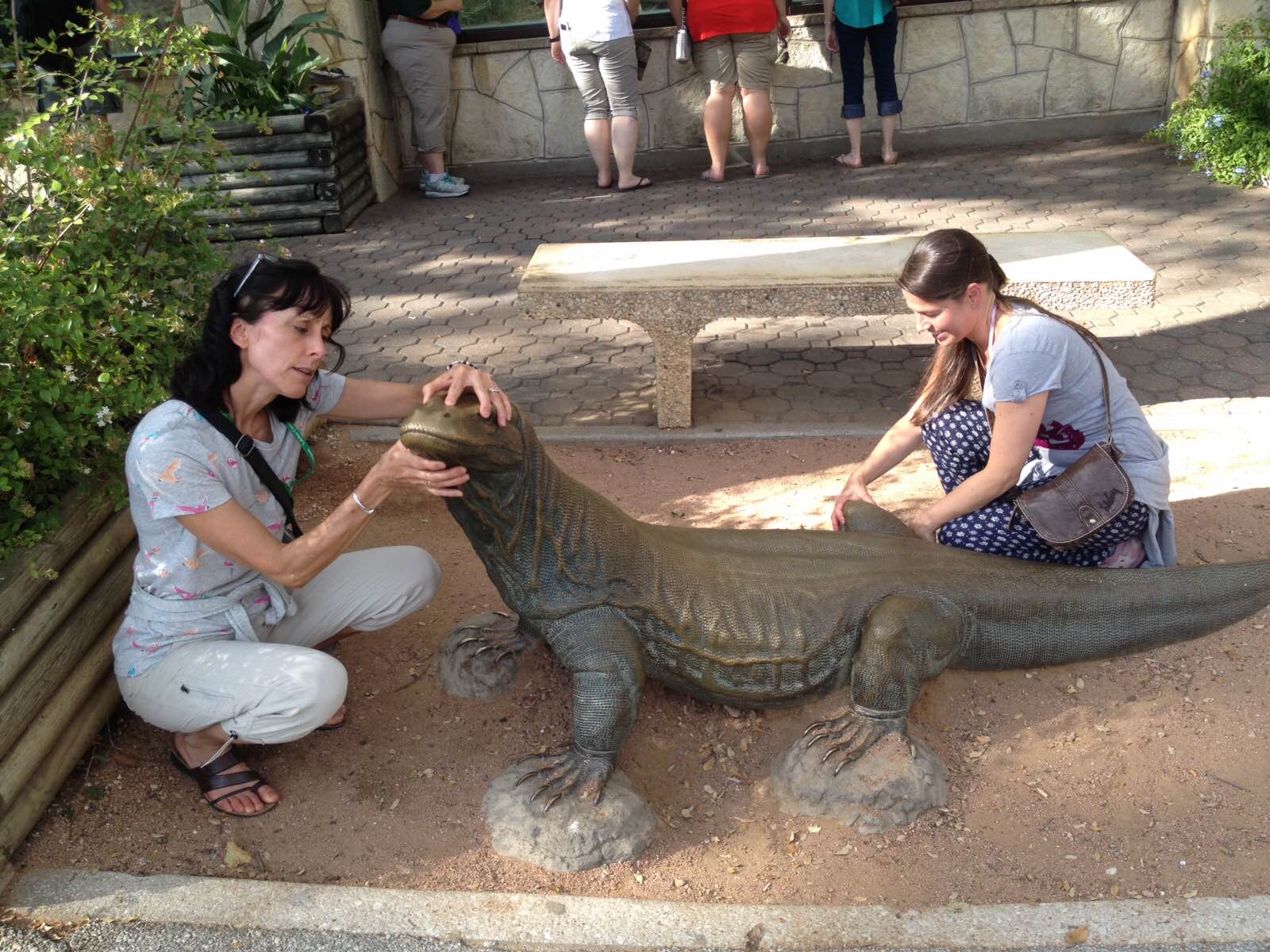 Hello from (clap clap clap clap) Deep in the Heart of Texas! In 24 hours I'll be attending the Association of Exotic Mammal Veterinarians' board meeting, then instructing a lab on rabbit facial surgeries at 8 AM the next day. This conference is the highlight of our year, and is a gathering of the best and brightest in exotic pet medicine. It's also Dr. Swisher's debut as she
Hello from (clap clap clap clap) Deep in the Heart of Texas! In 24 hours I'll be attending the Association of Exotic Mammal Veterinarians' board meeting, then instructing a lab on rabbit facial surgeries at 8 AM the next day. This conference is the highlight of our year, and is a gathering of the best and brightest in exotic pet medicine. It's also Dr. Swisher's debut as she  presents a terrific case report on sepsis in a rabbit: this rabbit was one of our own patients with a severe bacterial disease that Dr. Swisher managed for over a week before he was able to go home with his owner. Now she will present that case in the hopes of sharing what we leaned with our colleagues. More reports as they come in!
presents a terrific case report on sepsis in a rabbit: this rabbit was one of our own patients with a severe bacterial disease that Dr. Swisher managed for over a week before he was able to go home with his owner. Now she will present that case in the hopes of sharing what we leaned with our colleagues. More reports as they come in!
Big Changes for Avian and Exotic Animal Clinic
We say a fond goodbye to two members of staff. Dr. Amber Lee, who successfully completed her two year Avian residency, and is on the way to sitting for her final examination in the fall. Once that is completed, she will be a board-certified Avian specialist, through the American Board of Veterinary Practitioners (www. abvp.com). Dr. Lee goes on to head the exotics department at a VCA specialty hospital in Massachusetts. Check out Dr. Lee’s new practice here: http://www.vcaspecialtyvets.com/south-shore-weymouth
 We also say goodbye to Phil, our clinic degu, who after a series of health problems will retire from his enormous clinic condo in the examination room for a more manageable retirement home with one of our staff members. Peaceful, quiet surroundings should really help! Caring for older pets can be a challenge. If you have concerns for your aging pet, let us know and we will share our experiences to help your elder pet age gracefully and comfortably.
We also say goodbye to Phil, our clinic degu, who after a series of health problems will retire from his enormous clinic condo in the examination room for a more manageable retirement home with one of our staff members. Peaceful, quiet surroundings should really help! Caring for older pets can be a challenge. If you have concerns for your aging pet, let us know and we will share our experiences to help your elder pet age gracefully and comfortably.
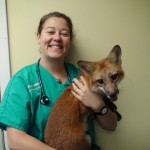 The clinic welcomes Dr. Elizabeth Shaw as our newest resident, who like Dr. Samantha Swisher is working towards a specialty in Exotic Companion Mammals. Dr. Shaw graduated from the veterinary school in Dublin, Ireland, and has a special interest in veterinary acupuncture. Look for more details on our “staff” page.
The clinic welcomes Dr. Elizabeth Shaw as our newest resident, who like Dr. Samantha Swisher is working towards a specialty in Exotic Companion Mammals. Dr. Shaw graduated from the veterinary school in Dublin, Ireland, and has a special interest in veterinary acupuncture. Look for more details on our “staff” page.
Holy Wind Tunnel, Batman!
People aren't the only ones having trouble with the recent storms. This morning the clinic was inundated with soaked and freezing wildlife, mostly baby birds blown from their nests. We heard reports that some of birds that didn't make it, but the survivors have been showing up since we opened at 8 AM.

But it's not just the birds-this morning we had a visit from a very water logged and grumpy wood chuck who apparently couldn't find high ground, along with a young raccoon.
Remember to never try to care for injured or orphaned wildlife yourself-we have an army of experienced and licensed wildlife rehabilitators who do a wonderful job providing care for immediate needs, and for the ultimate goal of successfully releasing animals back into the wild.
See our Wildlife page for more details, and how to reach rehabilitators.
A Case of Not-So-Yummy Beads
Exotic pets occasionally eat things that aren't actually food. The most common culprits are young ferrets, who are known for eating rubber, cloth and other unusual objects (we removed some red cloth from the intestines of a young ferret on April Fool's Day, which was not a good trick for her to play. Birds do this occasionally, too.
This is the story of Boom Boom, the 9 year old African Grey parrot who after all of this time should have known what was good to eat and what was not.
Boom Boom came in weak and not eating. Luckily, his owner agreed to let us run some blood tests and get some radiographs. A careful look showed bright objects in the ventriculus (part of the stomach of the bird). They appear uniform in appearance, which suggests they aren't small rocks or grit, but something man-made.
Since some innocent-appearing objects like beads or plastic can contain heavy metals or chemicals, some are actually very toxic. For this reason, we recommended that Boom Boom needed to part with his tiny objects.
A few years ago Dr. Larry Nemetz introduced a great technique for flushing material out of the stomachs of birds without the need for opening the body and then the stomach. This is exactly what we did with Boom Boom. The technique doesn't have an official name, but we like the term "Suck n' Flush". A small incision is made in the crop, and a tube gently introduced into the proventriculus (first part of the stomach). It's then gently flushed and aspirated until all of the stuff is gone, which is confirmed with another set of x-rays. This x-ray shows that a few of the beads are still remaining after the first attempt to flush them out (red arrow). The second attempt got the rest of them out. The bottom red arrow is pointing to the intraosseous catheter used to give Boom Boom fluids during surgery.
Here are Boom Boom's particles:
Boom Boom was so sick he stayed in the hospital for a week, and even required a blood transfusion. Luckily for Boom Boom, we had "Gandalf" a lovely African grey parrot in rescue who happened to be available for donation that day. After a week, Boom Boom was much better and went home. On the day Boom Boom went home, Gandalf happened to be in the reception room and they got to say "hi" from across the room!
 Here he is at recheck! You can see the bare spot where we made the incision to insert the tube for flushing. Even to this day his owner cannot find the source of the beads and Boom Boom is not telling! Mom is determined to keep a closer eye on that bird.
Here he is at recheck! You can see the bare spot where we made the incision to insert the tube for flushing. Even to this day his owner cannot find the source of the beads and Boom Boom is not telling! Mom is determined to keep a closer eye on that bird.
Dr. Lennox is back from iCare!
Dr. Lennox just returned from the iCare conference in Paris. iCare stands for: International Conference on Avian heRpetologica and Exotic mammal medicine. See more here! The conference was 6 days of exciting wet labs, masterclasses and lectures on birds, exotic mammals, reptiles and even zoo animals. Dr. Lennox taught a wet lab on exotic mammal intubation with colleagues Dr. Dan Johnson and JF Quinton, and assisted by hard-working resident Angel Curros and our old friend Dr. Rita Sousa.
There was plenty of new information to learn and teach, including new techniques on dealing with prolapse in tortoises, newer research on evaluating blood work in reptiles, information on the results of different types of ear surgeries in rabbits, and updates on strategies for avian behavioral problems.
We took turns at the Association of Exotic Mammal Veterinarians (AEMV) booth as well. AEMV is a professional organization dedicated to improving medicine and surgery of exotic companion mammals.
The best part is sharing our enthusiasm for exotic animal medicine with colleagues from so many parts of the world. It's absolutely true across the globe-the desire to offer the very best in exotic animal medicine and surgery is universal!
Calling All Rabbit Lovers!
 Come to our first annual Rabbit Health Day! Join us on Saturday, June 6th, 2015 for an afternoon of education, fun, and free prizes courtesy of Oxbow Animal Health. Come meet some adoptable
Come to our first annual Rabbit Health Day! Join us on Saturday, June 6th, 2015 for an afternoon of education, fun, and free prizes courtesy of Oxbow Animal Health. Come meet some adoptable bunnies from the Indiana House Rabbit Society and EARPS. Participants of Rabbit Health Day will qualify for a reduced cost annual exam for their rabbit the following Saturday! Even if you can't make it, help us spread the word to your rabbit-owning friends, and especially those who are thinking about adding a rabbit to the family. RSVP to exoticvetclinic@gmail.com. See you then!
bunnies from the Indiana House Rabbit Society and EARPS. Participants of Rabbit Health Day will qualify for a reduced cost annual exam for their rabbit the following Saturday! Even if you can't make it, help us spread the word to your rabbit-owning friends, and especially those who are thinking about adding a rabbit to the family. RSVP to exoticvetclinic@gmail.com. See you then!
The Joys of Foraging
At staff meeting this week we spend some time making Abba's next batch of foraging toys. Abba the Caique doesn't get food from a food dish....her food is hidden in paper cups and other destructible items to promote physical activity and mental stimulation. Foraging has been shown to reduce feather destructive behavior in some birds as well. All birds can learn to forage.
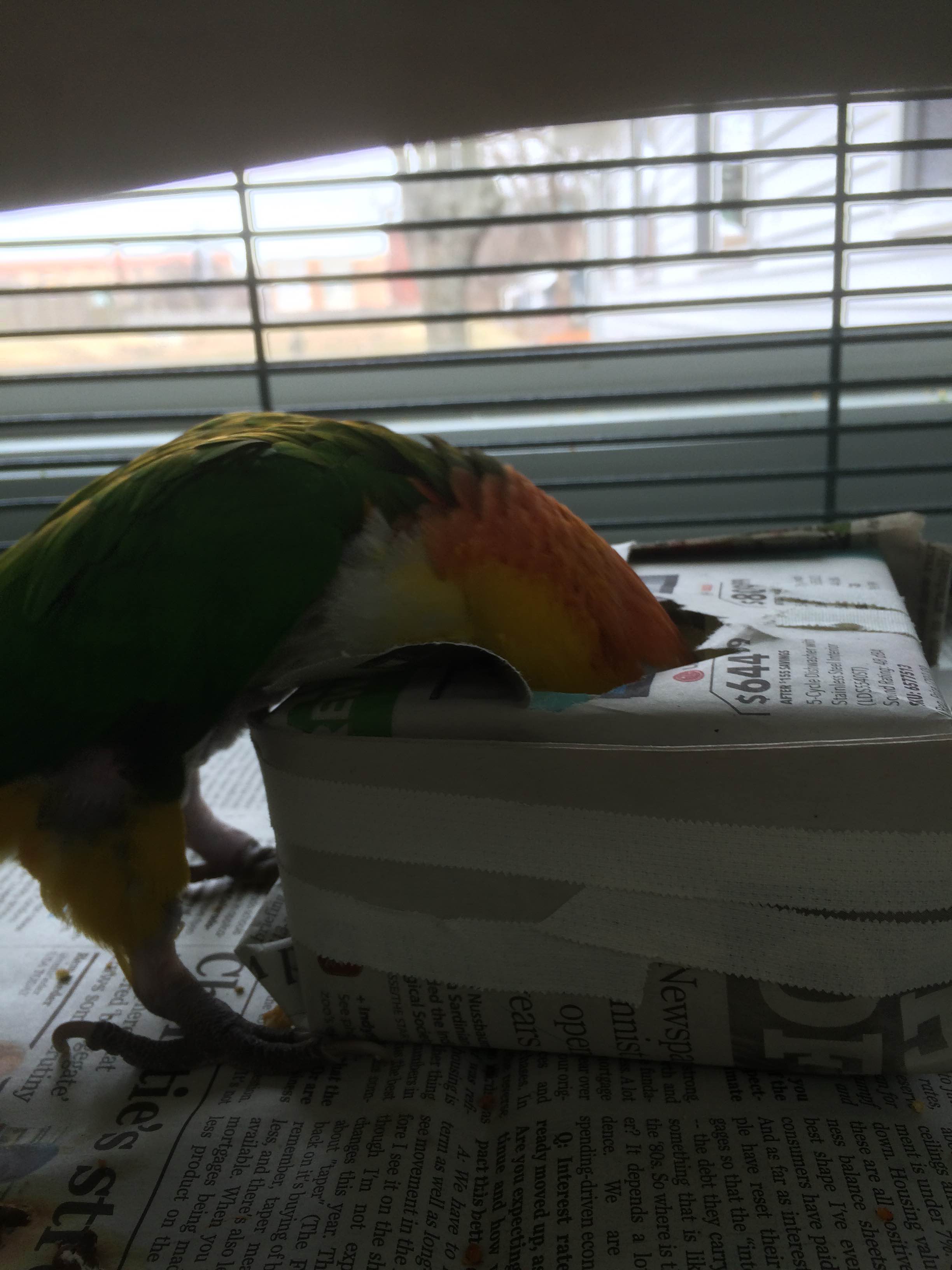 Here is a simple cardboard box taped up with newspaper. Inside are her regular bird pellets and a small treat (we recommend Lafeber's Nutriberries as healthy treats). There is a small hole cut in the top. Within minutes she was investigating.
Here is a simple cardboard box taped up with newspaper. Inside are her regular bird pellets and a small treat (we recommend Lafeber's Nutriberries as healthy treats). There is a small hole cut in the top. Within minutes she was investigating.
Here Abba is surveying an amazing creation of paper cups taped together to resemble a weird paper plant! Each cup contains pellets, but one contains a small treat as well. It's up to her to find it.
 Use your imagination to design foraging toys. Paper, masking tape, newspaper, paper cups and cardboard are all good choices. The staff came up with some creative toys for Abba for the coming week. Remember birds need to be taught to forage, if they've never tried it before.
Use your imagination to design foraging toys. Paper, masking tape, newspaper, paper cups and cardboard are all good choices. The staff came up with some creative toys for Abba for the coming week. Remember birds need to be taught to forage, if they've never tried it before.
For more on how to teach a bird to forage, go to "Jimmy's Page" for a complete tutorial featuring another cute bird.
Happy Easter
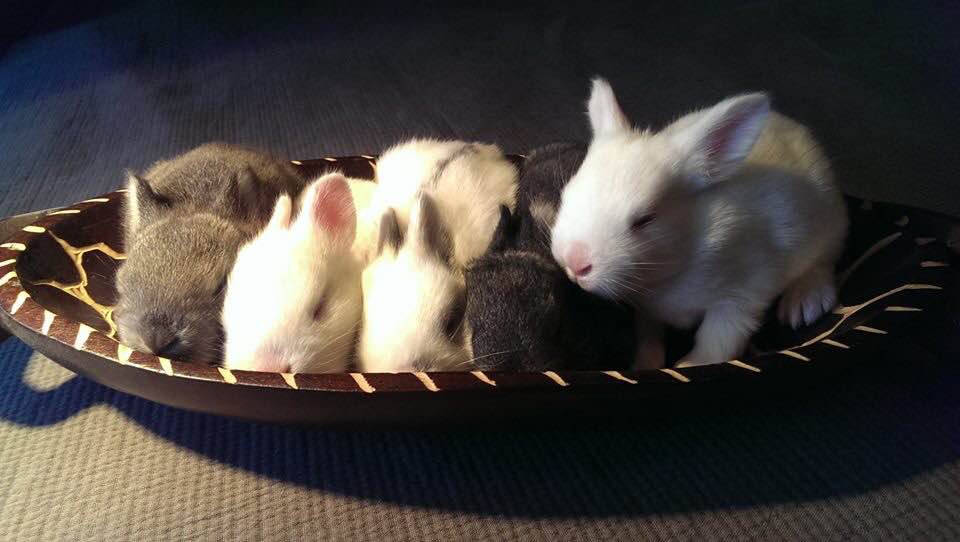 April 1st, 2015 This is the time of year when we see "Easter Bunnies", not just hiding eggs for us on Easter morning, but purchased for children as pets. While we LOVE rabbits as pets, we think it's important everyone understands that the cute baby bunny will grow up, will require up to 10 years of care, and may develop some personality quirks or other traits owners should be prepared for... For example these adorable fuzzy baby bunnies will grow up to be this:
April 1st, 2015 This is the time of year when we see "Easter Bunnies", not just hiding eggs for us on Easter morning, but purchased for children as pets. While we LOVE rabbits as pets, we think it's important everyone understands that the cute baby bunny will grow up, will require up to 10 years of care, and may develop some personality quirks or other traits owners should be prepared for... For example these adorable fuzzy baby bunnies will grow up to be this:
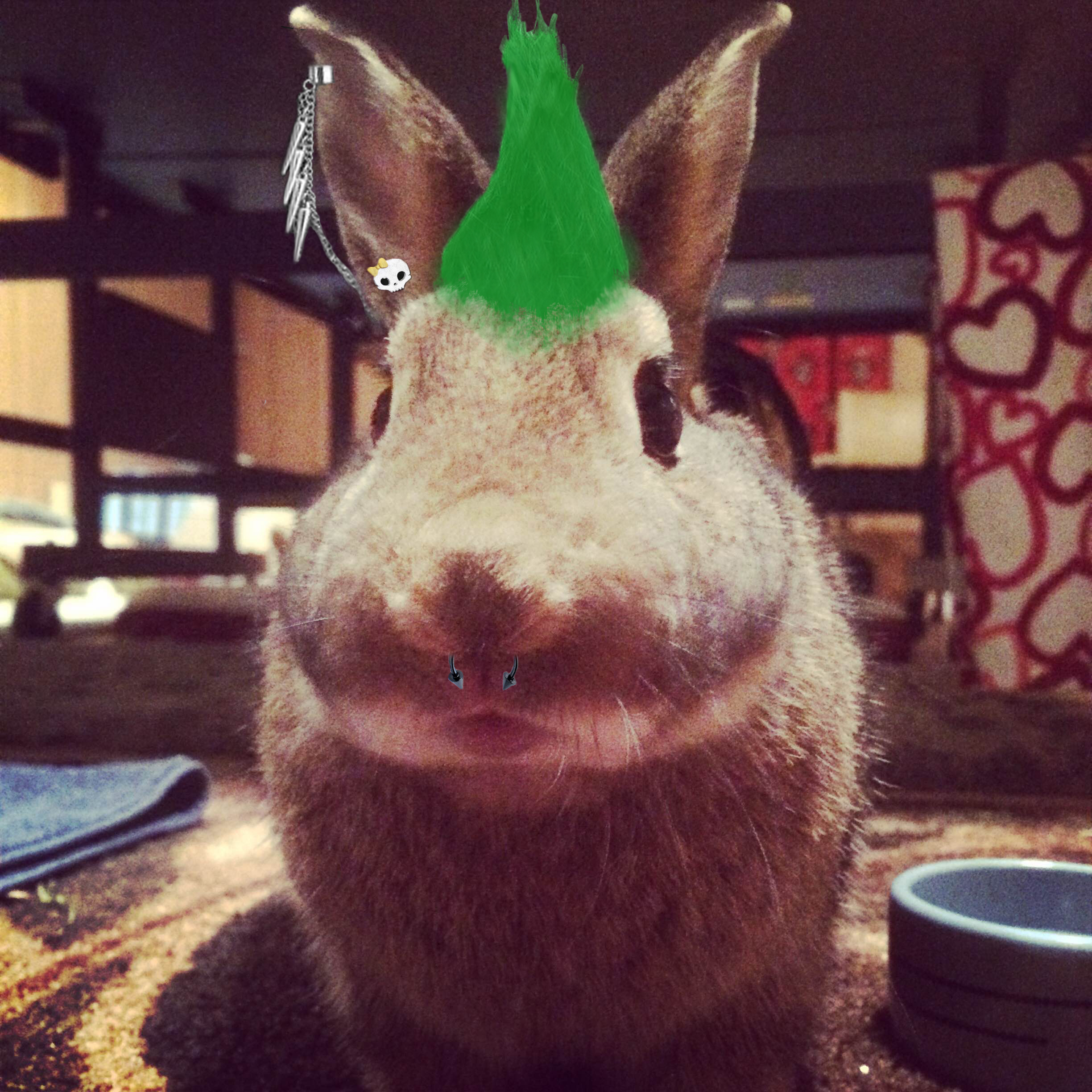
Of course, none of those photos are real BUT, baby bunnies are often a 10 year or more commitment, require as much care and attention as dogs and cats, and don't always make the best pets for children. Many of these guys are dumped into rescue, or worse, dumped outdoors to fend for themselves when the Easter novelty wears off. Give us a call, or visit Indiana House Rabbit Society's excellent website for more information on life with a House Rabbit.
Oh yes, and cute baby Easter chicks (and ducks) will grow up to be this:

